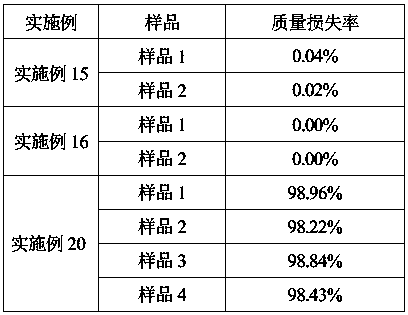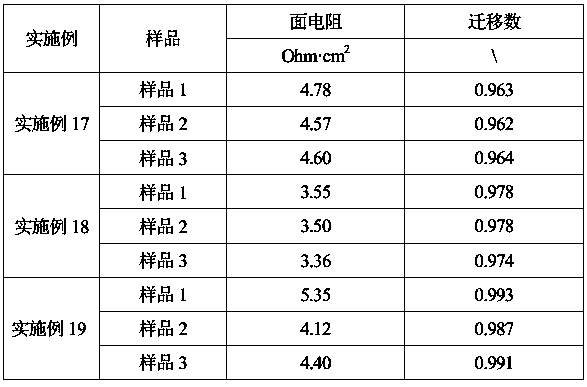Preparation method of crosslinking-type anion selective membrane
An anionic and selective technology, applied in chemical instruments and methods, membranes, membrane technology, etc., can solve the problems of complex preparation process and low cross-linking degree, achieve hydrophobic cross-linked structure, low production cost, membrane mechanical and thermal High stability effect
- Summary
- Abstract
- Description
- Claims
- Application Information
AI Technical Summary
Problems solved by technology
Method used
Image
Examples
Embodiment 1
[0027] Add 110 g of chlorobenzene into the three-necked flask, heat to 50°C, add 20 g of poly-2,6-dimethyl-1,4-phenylene ether, and stir; to be poly-2,6-dimethyl-1,4- After the phenyl ether is completely dissolved, add 26.7 g of bromine elemental substance, raise the temperature to 145°C and react for 8 hours; vacuum distill chlorobenzene from the solution at 110°C, and dry the remaining viscous material at 80°C to obtain bromomethylated poly-2,6 - Dimethyl-1,4-phenyl ether.
[0028] Bromomethylated poly-2,6-dimethyl-1,4-phenylene ether solid was dissolved in deuterated chloroform, and analyzed by nuclear magnetic resonance spectroscopy, bromomethylated poly-2,6-dimethyl-1,4-phenylene ether The benzene ring bromination degree of ether is 38%, and the methyl bromination degree is 56%.
Embodiment 2
[0030] Add 110 g of chlorobenzene into the three-necked flask, heat to 50°C, add 20 g of poly-2,6-dimethyl-1,4-phenylene ether, and stir; to be poly-2,6-dimethyl-1,4- After the phenyl ether is completely dissolved, add 44 g of N-bromosuccinimide; raise the temperature to 110°C, add 1 g of azobisisobutyronitrile; then raise the temperature to 145°C for 8 hours; pour the feed solution into the ethanol solution , the precipitated solid was bromomethylated poly-2,6-dimethyl-1,4-phenylene ether; the solid was dried at 80°C.
[0031] Bromomethylated poly-2,6-dimethyl-1,4-phenylene ether was dissolved in deuterated chloroform, and analyzed by nuclear magnetic resonance spectroscopy, bromomethylated poly-2,6-dimethyl-1,4-phenylene ether The degree of bromination of the benzene ring is 55%, and the degree of methyl bromination is 52%.
Embodiment 3
[0033] Add 110 g of chlorobenzene into the three-necked flask, heat to 50°C, add 20 g of poly-2,6-dimethyl-1,4-phenylene ether, and stir; to be poly-2,6-dimethyl-1,4- After the phenyl ether is completely dissolved, add 33g of N-bromosuccinimide; heat up to 110°C, add 1g of azobisisobutyronitrile; then heat up to 145°C for 8 hours; pour the feed solution into the ethanol solution, The precipitated solid was bromomethylated poly-2,6-dimethyl-1,4-phenylene ether; the solid was dried at 80°C.
[0034] Bromomethylated poly-2,6-dimethyl-1,4-phenylene ether solid was dissolved in deuterated chloroform, and analyzed by nuclear magnetic resonance spectroscopy, bromomethylated poly-2,6-dimethyl-1,4-phenylene ether The benzene ring bromination degree of ether is 35%, and the methyl bromination degree is 32%.
PUM
 Login to View More
Login to View More Abstract
Description
Claims
Application Information
 Login to View More
Login to View More - R&D
- Intellectual Property
- Life Sciences
- Materials
- Tech Scout
- Unparalleled Data Quality
- Higher Quality Content
- 60% Fewer Hallucinations
Browse by: Latest US Patents, China's latest patents, Technical Efficacy Thesaurus, Application Domain, Technology Topic, Popular Technical Reports.
© 2025 PatSnap. All rights reserved.Legal|Privacy policy|Modern Slavery Act Transparency Statement|Sitemap|About US| Contact US: help@patsnap.com



